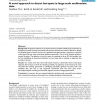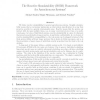136 search results - page 27 / 28 » separable and transitive graphoids |
BMCBI
2007
13 years 7 months ago
2007
Background: Progressive advances in the measurement of complex multifactorial components of biological processes involving both spatial and temporal domains have made it difficult...
JLP
2006
13 years 7 months ago
2006
As long as no cooperation between processes is supposed to take place, one may consider them separately and need not ask for the progress of the respective other processes. If a c...
IANDC
2007
13 years 7 months ago
2007
We define reactive simulatability for general asynchronous systems. Roughly, simulatability means that a real system implements an ideal system (specification) in a way that pre...
BMCBI
2005
13 years 7 months ago
2005
Background: The process of oxidative folding combines the formation of native disulfide bond with conformational folding resulting in the native three-dimensional fold. Oxidative ...
BMCBI
2004
13 years 7 months ago
2004
Background: Hidden Markov Models (HMMs) have proven very useful in computational biology for such applications as sequence pattern matching, gene-finding, and structure prediction...




